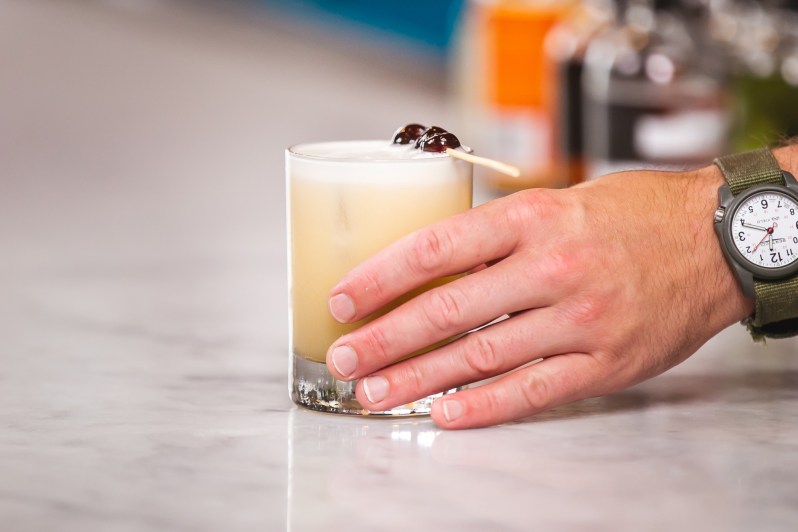
The Whiskey Sour officially dates back to the 1860s, but sailors in the British Navy had been drinking something very similar long before that. On long sea journeys, water was not always dependable, so to combat that, spirits were often used. Scurvy, too, was another danger on these journeys, so lemons and limes were consumed to help prevent the disease (incidentally, this is also one of the reasons why British folk are called ‘Limeys’). Finally, sugar and water were added for taste. At this point, the drink is probably starting to sound familiar. (Grog, the rum-based favorite of pirates across the seven seas, is made from the same components, substituting whiskey for the sugar cane-based spirit.)
When it comes to the official record, there are three main points of reference for the Whiskey Sour. The first written record comes in the seminal 1862 book The Bartender’s Guide: How To Mix Drinks by Jerry Thomas. The original recipe reads:
Original Whiskey Sour Recipe
- (Use a small bar-glass.)
- Take 1 large tea-spoonful of powdered white sugar dissolved in a little Seltzer or Apollinaris water
- The juice of half a small lemon
- 1 wine-glass of Bourbon or rye whiskey
Fill the glass full of shaved ice, shake up and strain into a claret glass. Ornament with berries.
(This recipe differs from the modern-day version in the style of glass and the type of ice used, but the prototype was there.)
The next reference comes from, of all places, an 1870 edition of the Waukesha Plainsdealer, a Wisconsin newspaper. The final reference to the drink comes two years later, in 1872. A former ship steward, Elliot Staub, “invented” a drink — the whiskey sour — in a bar in Iquique (then part of Peru). Through these three origins, we come to, more or less, what we have today–a cocktail that mixes a spirit, a sour, and a sweet.
Now that you’re read up and prepared for the day, it’s time to dive in. Check out George Dickel’s version of the original, then a few other takes on this iconic drink.
Whiskey Sour Recipe Variants
George Dickel Whisky Sour
(Pictured)
- 3 oz. George Dickel No.12 Whisky
- 5 oz. lemon juice
- 75 oz. simple syrup
Method: Shake and strain ingredients into an ice-filled rocks glass. Garnish with a lemon wedge or cherry.
Dewar’s Sour Rouge
(Created by Cyllan Hicks, New York City)
- 2 oz. Dewar’s 12 Blended Scotch Whisky
- 1 oz. Lemon Juice
- 1 oz. Rosemary Honey Syrup (1:1 honey and water with rosemary)
- ½ oz. Lillet Rouge
Method: Shake and pour over rocks. Add Lillet Rouge as floater. Garnish with lemon wheel and rosemary sprig.
Jeff’s Redneck Sour
- 1.25 oz. Bulleit Rye
- 1 oz. fresh lemon sour
- 5 oz. fresh grapefruit juice
- 2 dashes grapefruit bitters
Method: Shake and strain ingredients into an ice-filled rocks glass. Garnish with a grapefruit half wheel.
Basil Hayden’s Summer Sour
(By San Francisco Mixologist Matt Grippo)
- 1 ½ parts Basil Hayden’s Bourbon
- ½ part Fresh Lemon Juice
- ¾ part Sweet Vermouth
- ¼ part Tonic Syrup
- 2 dashes of Angostura Bitters
- Orange Twist (for garnish)
Method: Add all ingredients to a cocktail shaker with ice and shake vigorously for ten seconds. Strain into an iced filled rocks glass. Garnish with an orange twist.
- 1 ½ parts Knob Creek Bourbon
- ½ part Lemon Juice
- ½ part Simple Syrup
- 2 parts Orangina Soda
- 5 sprigs Thyme
- 1 Egg White



